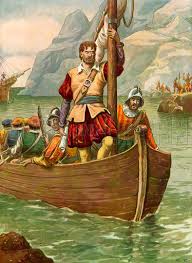Weaving First People’s Principles into Inquiry and Literacy
May 18, 2016 - 5 minutes readWhen asked to reflect on and write a personal response to Pauline Johnson’s “Lost Island”, Jenaya in Grade 7 shared this touching perspective.
“The Lost Island” by Pauline Johnson: Written Response
What do you think “The Island” represents and why do you think this?
“I think the island represents another side of you, which you have to look deep down to find. It’s where all your courage,strength and fearlessness is. It is something that the First Nations People had to do, to get back all the things that were taken from them, like their land, resources and culture. The First Nations peoples’ courage, strength and fearlessness has always been with us, but we had to look within ourselves to find it. When you finally find your inner courage, you find your power and your voice. Even though the First Nations Peoples lost so much, their courage, strength, and fearlessness is what got them through. Today that same courage is what is helping them to rebuild their resources and reclaim their culture. Even if you are not First Nations, the message that we all have courage, strength and fearlessness inside of us is a powerful one. If any person can learn to find that inner power, they will be able to find their voice too. If any person can learn to find that inner voice, they will be able to find their power too.”
lost island.jpg
When Ishita in Grade 5 researched into their class’s Big Idea she discovered a lot.
BIG IDEA: “Canada’s identity is shaped by conflict and cooperation between the First Peoples and Europeans.”
My Explorer:
Giovanni da Verrazano (1485-1528) was a French explorer working under King Francis I. He was hired to seek a passage to China using the Northwest Passage. Although he failed, he made many discoveries.
My Big Questions:
Did Giovanni da Verrazano meet any First Peoples?
If he did, was there conflict and/or cooperation?
My Research/Findings:
In my research, I found a letter written by Giovanni to King Francis I including information about his meeting with first peoples and his description of them as well as their land.
Summary of His Letter
This letter is filled with many interactions with First People, but only some information was necessary. Giovanni describes to his king how the land and scenery looked and the people who lived there. He also explained that the rumor some people spread was that he kidnapped a boy. However the truth is Giovanni met an old lady and kindly took the boy – probably with the lady’s permission. He tried to take a young woman as she was pretty and tall, but she shouted and was nearly impossible to bring so they left her and took the boy. Also, the letter describes how the First Nations were kind and did lots of trading.
Did Giovanni da Verrazano meet First Nations?
Answer: Yes, Giovanni da Verrazano met people of First Nations decent on his route to North America. Some fled in terror and some didn’t.
If he did, was there a conflict or was there cooperation?
Answer: Mostly there was no conflict at all. There was more trading and positive gesturing while trading. Some First Nation groups were unsure about Verrazano and his crew. There was only one conflict with the First Nations, which ended up being tragic. This was when Giovanni went on some unpopulated land in the Caribbean Sea and a cannibal tribe ate them. This was a tragic event and is the end of Giovanni’s tale.
Answer: Mostly there was no conflict at all. There was more trading and positive gesturing while trading. Some First Nation groups were unsure about Verrazano and his crew. There was only one conflict with the First Nations, which ended up being tragic. This was when Giovanni went on some unpopulated land in the Caribbean Sea and a cannibal tribe ate them. This was a tragic event and is the end of Giovanni’s tale.
Thank you to Mr. Loewen and Mrs. Hulme for facilitating these valuable learning opportunities and thank you to Jenaya and Ishita for allowing us to share their work.

Recent Comments